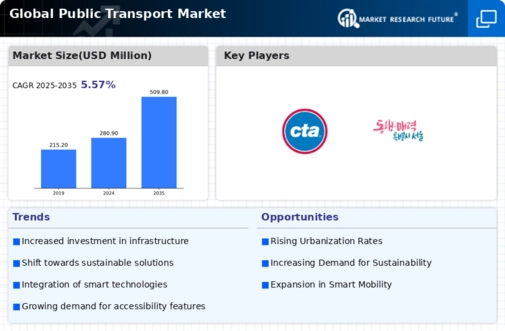Market Growth Projections
The Global Public Transport Market Industry is poised for substantial growth, with projections indicating a market value of 280.9 USD Billion in 2024 and an anticipated increase to 509.8 USD Billion by 2035. This growth trajectory suggests a compound annual growth rate of 5.57 percent from 2025 to 2035. Factors contributing to this expansion include urbanization, government investments, and technological advancements. The market's evolution reflects a broader trend towards sustainable and efficient public transport systems that cater to the needs of growing urban populations. As cities continue to develop, the demand for innovative public transport solutions is expected to rise.
Technological Advancements
Technological advancements are transforming the Global Public Transport Market Industry, enhancing efficiency and user experience. Innovations such as smart ticketing systems, real-time tracking, and electric vehicles are becoming increasingly prevalent. These technologies not only improve operational efficiency but also attract more users to public transport systems. The integration of data analytics and artificial intelligence into transport management systems is expected to optimize routes and reduce operational costs. As a result, the market is likely to witness a compound annual growth rate of 5.57 percent from 2025 to 2035, indicating a robust shift towards tech-driven public transport solutions.
Changing Consumer Preferences
Changing consumer preferences are reshaping the Global Public Transport Market Industry. As urban populations grow, there is a noticeable shift towards public transport as a preferred mode of commuting. Factors such as convenience, cost-effectiveness, and environmental impact are driving this change. Younger generations, in particular, are more inclined to utilize public transport over personal vehicles, reflecting a broader cultural shift towards sustainability. This trend is likely to contribute to the market's growth, with an anticipated value of 280.9 USD Billion by 2024. Public transport systems that adapt to these preferences by offering enhanced services and amenities may capture a larger share of the market.
Urbanization and Population Growth
The Global Public Transport Market Industry is experiencing a surge driven by rapid urbanization and population growth. As cities expand, the demand for efficient public transport systems intensifies. By 2024, the market is projected to reach 280.9 USD Billion, reflecting the increasing need for sustainable transport solutions. Urban areas are expected to house over 68 percent of the global population by 2050, necessitating robust public transport infrastructure. This trend indicates a shift towards integrated transport systems that can accommodate growing urban populations while reducing congestion and pollution, thereby enhancing the overall quality of urban life.
Government Initiatives and Investments
Government initiatives play a pivotal role in shaping the Global Public Transport Market Industry. Various countries are investing heavily in public transport infrastructure to promote sustainability and reduce traffic congestion. For instance, initiatives such as the European Union's Green Deal aim to enhance public transport systems across member states. These investments are likely to drive the market towards an estimated value of 509.8 USD Billion by 2035. Furthermore, governments are increasingly adopting policies that encourage the use of public transport, such as subsidies and tax incentives, which may further stimulate market growth and improve service accessibility.
Environmental Concerns and Sustainability
Growing environmental concerns are significantly influencing the Global Public Transport Market Industry. As awareness of climate change and air pollution rises, there is an increasing push towards sustainable transport solutions. Public transport systems are viewed as a viable alternative to reduce carbon footprints and promote eco-friendly commuting. Many cities are adopting electric and hybrid buses, which contribute to lower emissions. This shift towards sustainability is expected to bolster the market, with projections indicating a growth to 509.8 USD Billion by 2035. The emphasis on green transport solutions aligns with global efforts to combat climate change and promote sustainable urban development.














Leave a Comment